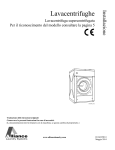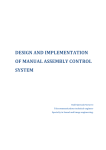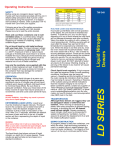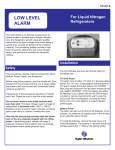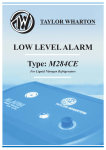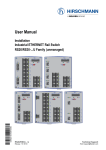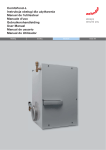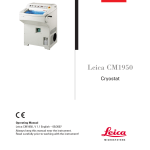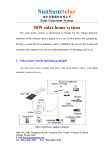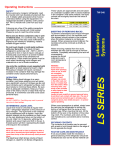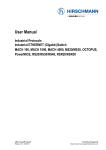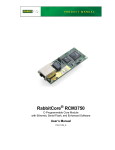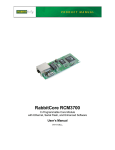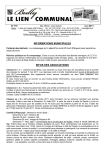Download CXR100 & CXR500 - Taylor Wharton
Transcript
TW-362 SAFETY Before using any cryogenic refrigerator, read the Handle with Care booklet provided with the unit. It details safety precautions that must be understood before using the equipment. If a replacement booklet is needed, order publication TW-10 Handle with Care from your supplier. Following are a few of the safety precautions described in the Handle with Care booklet. Please be sure to read the entire booklet. Store and use these containers only in well ventilated areas. In a confined area, nitrogen gas from these units may cause suffocation by displacing air needed for breathing. Install a suitable oxygen monitor. Do not touch liquid or cold metal surfaces with your bare skin. The liquid nitrogen refrigerant in these containers is extremely cold: -196°C (320°F). Exposure of skin or eyes to liquid, cold gas or frosted parts could result in a severe frostbite-like injury. Because of the extremely low temperature, a face shield and gloves must be worn when transferring liquid nitrogen and material into or out of these containers. Use only the necktube core supplied with this unit or a listed replacement part. A tight fitting plug or stopper will cause a pressure increase in the container that may damage the container and/or cause personal injury. Dispose of liquid nitrogen only in areas specifically designed for that purpose. Disposal of liquid nitrogen should be done outdoors in a safe place. Pour the liquid slowly on gravel or bare earth where it can evaporate without causing damage. OPERATION Important note: Before filling the CXR series for the first time, record the tare weight and serial number of each container. Recording the “as received” tare weight on the container itself is recommended. Filling: Adding liquid nitrogen to warm container may cause splashing and will generate a sufficient volume of nitrogen gas as cold liquid contacts warm refrigerator surfaces. Add liquid slowly to minimize these effects. Be sure there is adequate ventilation. Keep your head clear of the heavy volume of vapor that may be produced. It is extremely cold and could cause personal injury WARNING DO NOT OVERFILL. Over-filling may result in personal injury due to liquid spillage. With regular usage, moisture can accumulate in the refrigerator as a result of lowering a frosted canister back into the shipping cavity. This moisture will displace nitrogen in the adsorbent material on the subsequent filling and effect the overall holding time. CAUTION: When filling the Cryogenic Refrigerator, avoid liquid nitrogen coming in contact with the vacuum plug. In order to accomplish this, the Cryo-Exchange must be removed from its shipping carton during the “fill” operation. Remove the unit from its shipping enclosure. Set the unit on a scale and fill the refrigerator with liquid nitrogen to about half way up the necktube. Allow the unit to stand undisturbed while the liquid is being adsorbed. About every five minutes, add liquid to maintain the level half way up the necktube as the liquid is adsorbed by the filler material. This procedure can take four or more cycles. Replace the necktube core and allow it to “float” on the liquid. Allow the unit to stand undisturbed for 18 to 24 hours while the liquid is being adsorbed. After this point, the quantity of liquid standing in the central cavity of the refrigerator must be poured out to prevent spillage during shipment. To assure a complete fill, the dry CXR100 weight should increase by approximately 6.5 lb. (3.0 kg) and the dry CXR500 weight should increase by approximately 11.5 lb. (5.2 kg). The material to be stored in the CryoExchange refrigerator, as well as the canister or rack, should be pre-cooled before being placed in the shipper. When the refrigerator is fully charged, place the precooled canister and lower it into the necktube. Install the necktube core and cap to hold the canister in place. CAUTION: When the Cryo-Exchange is in use, it must be kept upright. When properly filled, there is no concern for liquid refrigerant spills. However, holding time will be drastically reduced when the refrigerator is on its side. Securing contents: The contents of all models may be secured with a seal or lock through tabs on the edge of the lid. ROUTINE CARE AND MAINTENANCE Do not attempt to fasten any device to the container. Welding, brazing, or piercing of the container in any manner will cause permanent damage. Cryo-Exchange Vapor Shippers With Replaceable Adsorbent Operating Instructions TW-362 Refrigeration depends on the presence of liquid nitrogen refrigerant in the refrigerator. Be sure to maintain a full charge of refrigerant to prevent loss of stored materials. Please refer to the “Operations” section of this document for instructions on the filling procedure. If you are not able to fully charge the Cryo-Exchange unit by weight, it is possible that moisture has accumulated in the filler material over time with normal usage. This accumulation will result in displacement of o o refrigerant. Direct dry heat not to exceed 150 F (65 C) (from a hair dryer or other source) into the refrigerator. The unit is acceptably dry when the tare weight is within 1 lb. (0.45 kg) of the “as received from the manufacturer” tare weight. If the tare weight is still not satisfactory, or contamination is suspected, a new set of adsorbent socks can be purchased to bring the unit back to factory specifications. REPLACING THE ADSORBENT FIGURE 1.0 TRANSPORTATION Although these refrigerators are rugged, they can be damaged if abused or otherwise mishandled. A specially designed hard-shell shipping container (refer to the parts section for ordering information) should be used anytime the refrigerator is transported. This container will help prolong the life of the unit and should be replaced if damaged during use. When moving or transporting a refrigerator, take every precaution to prevent sliding, tipping, bumping, or dropping the unit. Keep the unit upright. Although there is no safety hazard if the properly filled refrigerator is on its side, the refrigerant consumption is much greater with the unit in this position and holding time will be significantly reduced. RETURNS Manufacturing defects are covered under the containers limited warranty. Evidence of mishandling, such as dents on the outer vessel, or misalignment of the inner vessel, are not manufacturing defects. If high evaporation rates are apparent under normal operating conditions, the refrigerator may be losing its vacuum. Sweating and the formation of frost on the outer casing are indications the refrigerator may be losing its vacuum. All necessary steps should be taken to protect the refrigerator’s contents. Please contact your supplier for information on how to conduct a normal evaporation rate (NER) test in the field. If you would like to return goods to Taylor-Wharton for any reason, you must first obtain a Material Return Authorization (MRA) number for tracking purposes. Please have a description of your symptoms and your serial number ready. Contact your supplier or call us at 1-800 TW TANKS or e-mail us at [email protected]. REPLACEMENT PARTS Description A) B) C) D) E) F) G) On a clean working surface in a well ventilated area and the CXR at ambient temperature, begin by removing the cap assembly and canister (items 1 and 2) shown above in figure 1.0. Wearing gloves made from one of the following: polyethylene/ethylene vinyl alcohol, polyvinyl alcohol, Teflon or Viton, reach down the necktube and remove the core (item 3). Reach in and remove one at a time the 7 adsorbent socks (item 4). Dispose of the used socks properly. Clean the empty CXR (item 5) with an approved disinfectant, and then dry thoroughly. Replace the Adsorbent socks with TW part number CXR1009C30. Place the socks down the necktube standing them vertically around the perimeter of the CXR. Replace the Core (item 3) Fill the CXR per the procedure found in the operation section of this manual. CXR100 CXR500 Handle Handle, Pin Canister CXR100-6C12 8631-5000 CXR100-9C24 N/A N/A Note* Neckplug Assembly CXR100-9C16 CP70-9C18 Core Sleeve CXR100-9C20 Adsorbent Sock (Set) CXR100-9C30 CXR500-9C20 CXR100-9C30 (2 Sets) Decal CXR100-9C25 CXR500-9C25 Hard Shell Shipping Enclosure CX10-8C00 CP19-8C00 Padded Carton Shipping Enclosure 3701-9277 N/A Note*: Five shelf rack (for TW plastic box)…………RS30-9C40 Blood Bag Rack……………………………………….CP70-9C44 TW-362 4075 Hamilton Blvd. Theodore, Alabama 36582 U.S.A. Telephone (251) 443-8680 Fax (251) 443-2250 In U.S. and Canada: (800) TW TANKS (898-2657) ©2002 Harsco Corporation



